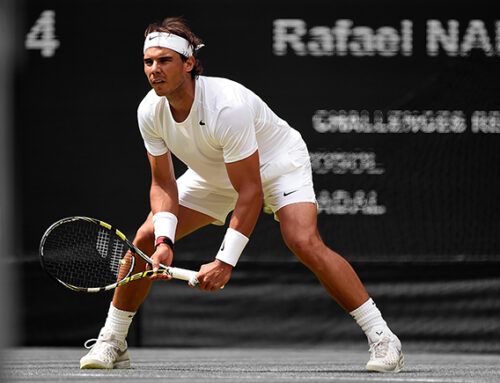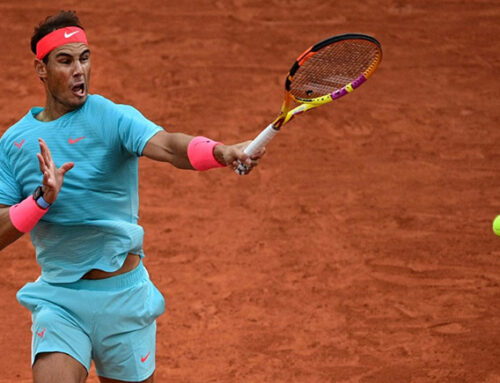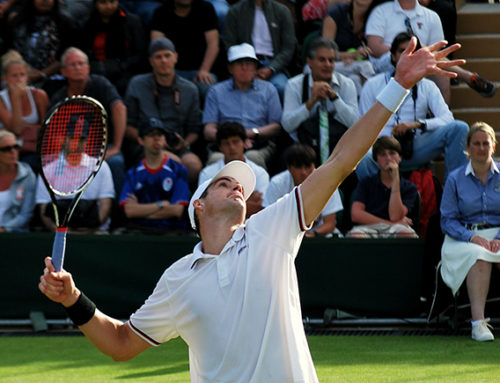Welcome to Part 3! We finished Part 2 with a big question: if a 6’3, athletic serve and volleyer is our best hope for serve and volley to return to the upper echelons of the game, why not Michael Llodra? He’s 6’3. He’s fast. His volley technique is superb. He has a world-class slice backhand and isn’t afraid to chip and charge on second serves. His service motion is good, and his serve has garnered praise from his fellow pros. So why can’t he break through? At 32 it isn’t a question of him peaking.
So what is holding Llodra back?
The Three Serves of Michael Llodra
It is, sadly his serve. Not his motion, per-se (although it isn’t ideal it is relatively clean). He is able to produce respectable velocity, peaking out close to 130 mph. Rather it is the predictability of it. There are two key elements to having an effective serve when serve and volleying:
1. Disguise – the ability to hit more than one serve off the same toss. For your opponent to not have the ability to ‘read’ your motion.
2. Variety – the more different types of serve you can hit with disguise, the more effective your disguise becomes.
The second of these is where Llodra falls flat. Because when push comes to shove Michael Llodra only has 3 serves and that just isn’t enough. I took some time to watch Llodra play, and map out his service speeds with spins and location, allowing me to break his serve down into his the deliveries.
The Fast Ball
The first is Llodra’s “fast ball”. There are quotations around it for two reasons – even his flattest serves typically carry a little slice on them, and his fast ball is, in today’s terms not all that fast. Llodra uses this serve approximately 40% of the time on his first serve, and almost always in the traditional ‘flat’ locations for a lefty – out wide on the deuce court and down the middle on the ad side.
It has a relatively narrow velocity range – the vast majority of them fall between 122 and 125 miles an hour. That’s only a 3 mile per hour range, with relatively little side to side movement. While Llodra can occasionally crank the velocity up a little from there, it is extremely rare for him to reach 130 mph.
The Slider
This is Llodra’s off-pace first serve that he hits primarily up the middle on the deuce court, and out wide on the ad. He gets great location on it and the ball has a good amount of left to right (from his perspective) movement on it. Unfortunately, again those speeds are all within a very narrow range. At the low end, Llodra’s slider clocks in around 108 mph, and tops out around 112 mph. This is in the second-serve velocity territory for a lot of the top players, which in and of itself isn’t a disaster – again his location and movement are great. However when we keep in mind he only has one more delivery left to show his opponents…
The Topspin Slice
Last but not least, Llodra brings out the topspin slice. He will occasionally hit this as a pure topspin slice, and very rarely as a genuine kick serve. But the vast, vast majority of the time he hits it as a topspin slice and the velocity is nothing to get excited about. This one he typically puts in the 94-98 mph range. This is far too slow for this type of serve – back in the late 90’s Rafter was hitting the same kind of topspin slice delivery up in the 110+ mph range.
Two Locations
And here is the last nail in the coffin for Llodra. His location. By and large he hits two spots on his serves – the corners. The vast, vast majority of his deliveries, especially on the first serve, are to either corner of the box. There is a distinct lack of body serves in his game of any variety. He will throw them out occasionally, but they are few and far between.
When we look at Federer’s serving patterns, it is clear the level of thought and care that go into his serve locations – especially on the second serve. Federer hits the vast majority of his second serves to the body on the left side of his opponent. This forces the opponent to mostly push the ball away from themselves, and garners Federer a forehand for his first groundstroke of the rally. When Federer gets a forehand to start the point, he wins the point the majority of the time.
Lacking True Variety
Three relatively distinct deliveries to mostly two locations just isn’t enough at the top of the game. And to make matters worse, they all have a variation of the same lateral movement on them – from his opponent’s right to their left. The predictability of the bounce in this case takes away a huge element from his game. At that level for the type of serve and volleyer Llodra is, his general goal isn’t to serve aces. It is to make his opponent hit their returns off-center, sometimes by as little as two inches. It’s to have them mis-time the return by literally hundredths of a second. Those small margins at the racket-head speeds of the top pros makes a huge difference in the control of the return. That ankle-high ball suddenly is waist or even shoulder height. Instead of inches inside the line it falls wide or several feet inside the sidelines where Llodra could reach it.
When we take into account that Llodra is fairly predictable with the type of serve he hits to which location, it becomes even easier for his opponents to get into a returning rhythm. His ‘T’ serves on the deuce side will all be within a very narrow range of velocities and heights. His wide serves on the deuce will all be within a very narrow range of velocities and heights. He takes the guess-work out of it.
Imagine instead this as a returner:
0-0: Llodra steps up and drops a 127 mph bomb flat and wide out to your forehand (assuming you are right-handed).
15-0: Llodra slides you out wide again at 112 mph, the ball cutting away from you with lefty slice.
30-0: Off the same toss as the first two serves, Llodra serves a ball headed out wide. You get the jump on it, but it’s slower than the first one, and curving. Off-rhythm and moving to your right, the ball curves into your body jamming you on your right hip instead of the full stretch you anticipated.
30-15: Llodra drops one at 117 mph that seems to be right in the strike zone of your forehand. However it curves inwards and keeps rising. You end up playing the ball where your head was a fraction of a second earlier.
40:15: Llodra brings the heat again – 129 mph straight at your body.
A sample game, but all of this is also setting up serves for later in the match. That’s the thing about smart, effective serve and volleying. It’s a game of cat and mouse. You’re always thinking two steps ahead, playing off tendencies and patterns to try to get your opponent anticipating and then yanking the proverbial rug out from under them.
Llodra needs to develop a true lefty kick serve (or if he really has one hiding somewhere in his repertoire, he needs to bring it out more often). He also really needs another 5 mph at the top end of his velocity. If his slider was up at 15-117 mph instead, if he could drop nasty kickers in at ~110 mph, then that might well make the difference for him.
But he’s 32 years old. He seems healthy, and despite his odd personality and possible racist/misogynistic tendencies, in no rush to retire. It isn’t too late for him to make a dent, given he reached his career peak of 21 a little over a year ago now at 31. This is, however unlikely. But the take-home from Michael Llodra is this: if a 31 year old serve and volleyer with a relatively mediocre serve for the top of the pro tour can break into the top 30, what would a 25 year old with a genuinely great serve be able to do? Top 10? Top 5? #1? Here is hoping we get to find out!


